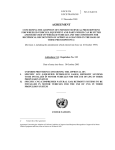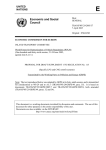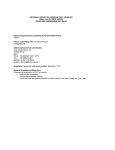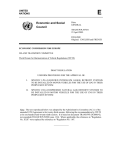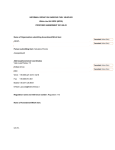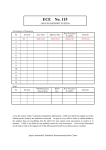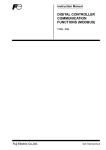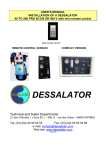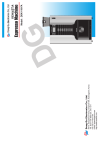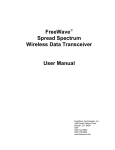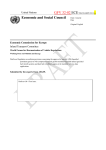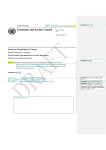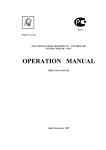Download Agreement
Transcript
E/ECE/324/Rev.2/Add.114/Amend.4−E/ECE/TRANS/505/Rev.2/Add.114/Amend.4 12 October 2010 Agreement Concerning the Adoption of Uniform Technical Prescriptions for Wheeled Vehicles, Equipment and Parts which can be Fitted and/or be Used on Wheeled Vehicles and the Conditions for Reciprocal Recognition of Approvals Granted on the Basis of these Prescriptions* (Revision 2, including the amendments which entered into force on 16 October 1995) Addendum 114: Regulation No. 115 Amendment 4 Supplement 4 to the original version of the Regulation: Date of entry into force: 19 August 2010 Uniform provisions concerning the approval of: I Specific LPG (liquefied petroleum gases) retrofit systems to be installed in motor vehicles for the use of LPG in their propulsion system II. Specific CNG (compressed natural gas) retrofit systems to be installed in motor vehicles for the use of CNG in their propulsion system UNITED NATIONS * Former title of the Agreement: Agreement Concerning the Adoption of Uniform Conditions of Approval and Reciprocal Recognition of Approval for Motor Vehicle Equipment and Parts, don’t at Geneva on 20 March 1958. GE.10- E/ECE/324/Rev.2/Add.114/Amend.4 E/ECE/TRANS/505/Rev.2/Add.114/Amend.4 The text of the Regulation, amend to read: “Regulation No. 115 Uniform provisions concerning the approval of: I. Specific LPG (liquefied petroleum gases) retrofit systems to be installed in motor vehicles for the use of LPG in their propulsion system II. Specific CNG (compressed natural gas) retrofit systems to be installed in motor vehicles for the use of CNG in their propulsion system 1. Scope This Regulation applies to: 1.1. Part I: Specific LPG retrofit systems to be installed in motor vehicles for the use of LPG in the propulsion system. Part II: Specific CNG retrofit systems to be installed in motor vehicles for the use of CNG in the propulsion system. 1.2. This Regulation applies when the retrofit systems manufacturer keep the initial characteristics of the whole system, for the specific vehicle family for which the approval has been granted. 1.3. This Regulation does not apply to the procedures, checks and inspections aimed at verifying the correct installation of the retrofit systems on vehicles, since this matter relies on the competence of the Contracting Party of Country where the vehicle is registered. 1.4. This Regulation applies to retrofit systems intended to be fitted on vehicles of categories M and N, with the exception of: 1.5. (a) Vehicles type-approved pursuant to Regulation No. 83, series of amendments 00 or 01 or 02 or 03 or 04 series, (b) Vehicles type-approved pursuant to Regulation No. 49, series of amendments 00 or 01 or 02 or 03 series, (c) Vehicles type-approved pursuant to EC Directive 70/220/EEC up to and including the amending Directive 96/69/EC, (d) Vehicles type-approved pursuant to EC Directive 88/77/EEC up to and including the amending Directive 96/1/EC. The requirements for the different categories (M1, N1 or others) are defined in paragraphs 2. to 7.1. Once the retrofit system is installed in the vehicle, the modified vehicle shall fulfil all the provisions of the Regulation for which the type approval has been initially granted. 1 2 Regarding safety requirements, it is recommended that the minimum requirements of Regulation No. 67, 01 series of amendments and Regulation No. 110 shall apply to all retrofitted vehicles. E/ECE/324/Rev.2/Add.114/Amend.4 E/ECE/TRANS/505/Rev.2/Add.114/Amend.4 2. Definitions 2.1. “Approval of an LPG or CNG retrofit system” means the approval of the type of retrofit system to be installed in motor vehicles for the use of LPG or CNG. 2.1.1. Specific LPG retrofit system of an approved type may consist of several components as classified and approved according to Regulation No. 67, 01 series of amendments, Part I and the specific vehicle instruction manual. 2.1.2. Specific CNG retrofit system of an approved type may consist of several components as classified and approved according to Regulation No. 110, Part I and the specific vehicle instruction manual. 2.1.3. “A vehicle is considered mono-fuel”, when, after the retrofit operation, it is equipped with a petrol tank of capacity ≤ 15 litres, that can only be used to “limp-home”. 2.1.4. “A vehicle is considered bi-fuel”, when after the retrofit, it is equipped to operate on both petrol and LPG or CNG, with a petrol tank capacity exceeding 15 litres. 2.1.5. “Master-slave system” means a retrofit system in which the LPG Electronic Control Unit (ECU) or CNG ECU is able to translate the petrol ECU control strategy in LPG or CNG operation. 2.1.6. “Original vehicle” means a vehicle before the installation of the retrofit system. 2.2. “Specific LPG or CNG retrofit system of an approved type” means systems, which do not differ in such respect as: 2.2.1. Retrofit system manufacturer (responsible for retrofit approval application); 2.2.2. Pressure regulator/vaporiser type by the same manufacturer; 2.2.3. Gas fuelling system type by the same manufacturer (i.e. induction mixer, injector device, vapour or liquid, single or multi-point injection system); 2.2.4. Sensors and actuators set types; 2.2.5. The fuel container type (i.e. LPG liquid take off / vapour pressure, LPG vapour take off, LPG liquid take off / pressurized by pump, pressurized CNG take off), the safety devices and fuel container accessories, as required by Regulation No. 67, 01 series of amendments, or Regulation No. 110, where applicable (i.e. relief valve); 2.2.6. Fuel container fitting devices; Note: With respect to paragraphs 2.2.4., 2.2.5. and 2.2.6., the manufacturer of the retrofit can insert in his installation manual other components, included in the approval, as interchangeable items (see para. 7). 2.2.7. ECU type by the same manufacturer; 2.2.8. Basic software principles and control strategy; 2.2.9. Installation manual (see para. 7); 2.2.10. End-user manual (see para. 7). 2.3. “System manufacturer” means an organization which can assume technical responsibility for the manufacturing of LPG and CNG retrofit systems and 3 E/ECE/324/Rev.2/Add.114/Amend.4 E/ECE/TRANS/505/Rev.2/Add.114/Amend.4 can demonstrate that it possesses the features required and the necessary means to achieve quality assessment and conformity of production of the retrofit system. 2.4. “Installer” means an organization which can assume technical responsibility for the correct and safe installation of the approved LPG and CNG retrofit system, in conformity with respectively paragraphs 6.1.1.3. and 6.2.1.3. of this Regulation2. 2.5. For the purposes of this Regulation, “the parent vehicle”, with regard both to LPG system and to CNG system, means a vehicle that is selected to act as the vehicle, on which the requirements of this Regulation are going to be demonstrated, and to which the members of a family refer. 2.5.1. According to this Regulation, “a member of the family” is a vehicle sharing the following essential characteristics with its parent vehicle: The family definition is based on the original vehicle characteristics. 2.5.1.1. (a) It is produced by the same vehicle manufacturer. (b) It is classified in the same category M1 or M2 or M3 or N1 or N2 or N3. Vehicles of category M1 and N1 class I may belong to the same family. (c) It is subject to the same emission limits or those specified in earlier series of amendments of the applicable Regulation. (d) If the gas fuelling system has a central metering for the whole engine: it has an approved power output between 0.7 and 1.15 times that of the engine of the parent vehicle. If the gas fuelling system as an individual metering per cylinder: it has an approved power output per cylinder between 0.7 and 1.15 times that of the engine of the parent vehicle. (e) Fuel feed and combustion process (injection: direct or indirect, singlepoint or multi-point). (f) It has the same pollution control system: (i) Same type of catalyst if fitted (three-way, oxidation, DeNOx) (ii) Air injection (with or without) (iii) Exhaust gas recirculation (EGR) (with or without) If the tested vehicle was not equipped with air-injection or EGR, engines with these devices are allowed. 2 4 2.5.1.2. With regard to the requirement of paragraph 2.5.1.1.(a), the vehicle family can also cover vehicles produced by other vehicle manufacturers if it can be demonstrated to the type approval authority that the same engine type and emission strategy is used. 2.5.1.3. With regard to requirement of paragraph 2.5.1.1.(d): In the bounds of the legislative power of the Contracting Party, as stated in paragraph 1.3. of this Regulation, in order to ensure a proper qualification of the installer, it is recommended to require valid certificates, issued by the system manufacturer and/or by skilled organizations, attesting the personnel's necessary expertise and the workshop's suitability to carry out retrofit system's installation. E/ECE/324/Rev.2/Add.114/Amend.4 E/ECE/TRANS/505/Rev.2/Add.114/Amend.4 (a) In the case of a central metering for the whole vehicle where a demonstration shows that two gas fuelled vehicles could be members of the same family with the exception of their approved power output, respectively P1 and P2 (P1 < P2), and both are tested as if they were parent vehicles, the family relation will be considered valid for any vehicle with an approved power output between 0.7*P1 and 1.15*P2; (b) In the case of an individual metering per cylinder where a demonstration shows two gas fuelled vehicles could be members of the same family with the exception of their approved power output, respectively P1 and P2 (P1 < P2), and both are tested as if they were parent vehicles, the family relation will be considered valid for any vehicle with an approved power output between 0.7*P1 and 1.15*P2. 2.5.1.4. With regard to the requirement of paragraph 2.5.1.1.(f) in case of a “masterslave” system, as defined in paragraph 2.1.6., the family relation will be considered valid regardless of the presence of the air injection or the EGR. 2.6. For definitions of the components of LPG retrofit systems refer to Regulation No. 67, 01 series of amendments. 2.7. For definitions of the components of CNG retrofit systems refer to Regulation No. 110. 3. Application for approval 3.1. The application for approval of a specific retrofit system shall be submitted by the manufacturer or by his duly accredited representative. 3.2. It shall be accompanied by the under-mentioned documents in triplicate and by the following details: 3.2.1. Description of the retrofit system comprising all the relevant details, included the approval numbers of each component referred to in Annex 3A to this Regulation for LPG system and Annex 3B to this Regulation for CNG system; 3.2.2. Description of the parent vehicle(s) on which the requirements of this Regulation are going to be tested; 3.2.3. Description of all modifications applied to the original parent vehicle, only in case of bi-fuel configuration; 3.2.4. Verification of compliance with the specifications prescribed in paragraph 6 of this Regulation; 3.2.5. If needed for the purpose of paragraph 5.2., notice of approval of the retrofit system for a parent vehicle which is different from those the approval is applied for, certifying that the retrofit system has been approved as a “master-slave” system, as defined in paragraph 2.1.5. 3.3. Installation manual(s) for the retrofit system installation on the parent vehicle(s). 3.4. End-user manual. 3.5 A sample of the specific retrofit system, properly installed in the parent vehicle(s). 5 E/ECE/324/Rev.2/Add.114/Amend.4 E/ECE/TRANS/505/Rev.2/Add.114/Amend.4 6 4. Markings 4.1. The sample(s) of a specific retrofit system submitted to type approval shall be accompanied by a plate with the trade name or mark of the retrofit manufacturer and the type, as indicated in Annexes 2A and 2B. 4.2. All retrofit systems, installed in the vehicle belonging to the family, as defined in paragraph 2., shall be identified by a plate, in which the approval number, and the technical specifications, as required in Annexes 2A and 2B shall be placed. This plate has to be permanently fixed to the structure of the vehicle and shall be clearly readable and indelible. 5. Approval 5.1. If the retrofit system sample submitted for approval meets the requirements of paragraph 6. of this Regulation, the type approval of the retrofit system shall be granted. 5.2. Retrofit systems, which have already been approved as “master-slave” systems on at least one parent vehicle, do not need to comply with paragraph 6.1.4.4.2.1. or 6.2.4.4.2.1. of this Regulation. 5.3. An approval number shall be assigned to each type of the retrofit system approved. Its first two digits (at present 00 according to the Regulation in its original form) shall indicate the series of amendments incorporating the most recent major technical amendments made to the Regulation at the time of issue of the approval. The same Contracting Party shall not assign the same type approval number to another type of retrofit system. 5.4. Notice of approval or of refusal or of extension of approval of a retrofit system type/part pursuant to this Regulation shall be communicated to the Parties to the Agreement applying this Regulation, by means of a form conforming to the model in Annexes 1A and 1B to this Regulation. 5.5. An international approval mark shall be affixed in the plate as indicated in Annexes 2A and 2B, to all retrofit systems, conforming to a type approved under this Regulation, in addition to the mark prescribed in this paragraph 4.1. This approval mark shall consist of: E/ECE/324/Rev.2/Add.114/Amend.4 E/ECE/TRANS/505/Rev.2/Add.114/Amend.4 3 5.5.1. A circle surrounding the letter “E” followed by the distinguishing number of the country which has granted the approval3; 5.5.2. The number of this Regulation, followed by the letter “R”, a dash and the approval number to the right of the circle defined in paragraph 5.5.1. The approval number consists of the retrofit system type approval number, which appears in the communication form for this type (see paragraph 5.2. and Annexes 1A and 1B) preceded by two figures indicating the latest series of amendments to this Regulation. 5.6. The approval mark shall be clearly readable and be indelible. 5.7. Annexes 2A and 2B to this Regulation give examples of the arrangement of the aforesaid plate with approval mark. 6. Specifications regarding the retrofit systems 6.1. Part I - LPG retrofit system specifications: 6.1.1. Requirements for the installation of specific equipment for the use of LPG in the propulsion system of a vehicle 6.1.1.1. An LPG retrofit system shall consist at least of the following components: 6.1.1.1.1. Components indicated in Regulation No. 67, 01 series of amendments and defined as necessary, 6.1.1.1.2. Installation manual, 6.1.1.1.3. End-user manual. 6.1.1.2. The LPG retrofit system may also include components indicated as optional in Regulation No. 67, 01 series of amendments. 6.1.1.3. The LPG retrofit system installed in the vehicle, in a proper way as defined in the above installation manual, shall comply with the installation requirements of Regulation No. 67, 01 series of amendments. Concerning the fixation of the fuel container, the requirements of Regulation No. 67, 01 series of amendments shall be deemed to be met if the requirements of Annex 5 to the present Regulation are satisfied. 1 for Germany, 2 for France, 3 for Italy, 4 for the Netherlands, 5 for Sweden, 6 for Belgium, 7 for Hungary, 8 for the Czech Republic, 9 for Spain, 10 for Serbia and Montenegro, 11 for the United Kingdom, 12 for Austria, 13 for Luxembourg, 14 for Switzerland, 15 (vacant), 16 for Norway, 17 for Finland, 18 for Denmark, 19 for Romania, 20 for Poland, 21 for Portugal, 22 for Russian Federation, 23 for Greece, 24 for Ireland, 25 for Croatia, 26 for Slovenia, 27 for Slovakia, 28 for Belarus, 29 for Estonia, 30 (vacant), 31 for Bosnia and Herzegovina, 32 for Latvia, 33 (vacant), 34 for Bulgaria, 35 (vacant), 36 for Lithuania, 37 for Turkey, 38 (vacant), 39 for Azerbaijan, 40 for The former Yugoslav Republic of Macedonia, 41 (vacant), 42 for the European Union (Approvals are granted by its Member States using their respective ECE symbol), 43 for Japan, 44 (vacant), 45 for Australia, 46 for Ukraine, 47 for South Africa, 48 for New Zealand, 49 for Cyprus, 50 for Malta, 51 for the Republic of Korea, 52 for Malaysia, 53 for Thailand, 54 and 55 (vacant), 56 for Montenegro, 57 (vacant) and 58 for Tunisia. Subsequent numbers shall be assigned to other countries in the chronological order in which they ratify the Agreement Concerning the Adoption for Uniform Technical Prescriptions for Wheeled Vehicles, Equipment and Parts which can be fitted and/or be Used on Wheeled Vehicles and the Conditions for Reciprocal Recognition of Approval Granted on the Basis of these Prescriptions, and the numbers, and the numbers thus assigned shall be communicated by the Secretary-General of the United Nations to the Contracting Parties to the Agreement. 7 E/ECE/324/Rev.2/Add.114/Amend.4 E/ECE/TRANS/505/Rev.2/Add.114/Amend.4 6.1.2. Pollutants emissions and CO2 emissions (for category M1 and N1 vehicles only) 6.1.2.1. One LPG retrofit system sample, as described in paragraph 2.2. of this Regulation, installed into the parent vehicle(s), as described in paragraph 2.5. of this Regulation, shall be submitted to the test procedures described in Regulations No. 834 and No. 101, or No. 495, where applicable, in the limits of the requirements of paragraphs 6.1.2.4. and 6.1.2.5. The vehicles and/or the engines are also submitted to a maximum power comparison test, as described in Regulation No. 85 for engines, or defined in paragraph 6.1.3. below for vehicles. 6.1.2.2. Fuel requirements by the engine: the type of fuel normally used by the engine could be: (a) LPG only (mono-fuel) (b) Both unleaded petrol or LPG (bi-fuel) (c) Both diesel fuel or diesel fuel and LPG (dual fuel) (Provisions for dual fuel have still to be defined). 6.1.2.3. “Pollutants” means: (a) Carbon monoxide (b) Hydrocarbons assuming a ratio: CH1,85 for petrol, CH1,86 for diesel fuel, CH2,52 for LPG, CH (to be defined) 4 5 8 for dual fuel; (c) Oxides of nitrogen, the latter being expressed in nitrogen dioxide (NO2) equivalent. (d) Particulates, etc. 6.1.2.4. Exhaust emissions and CO2 emissions (M1 and N1 category of vehicles): 6.1.2.4.1. Specific requirements on the Type I test (verifying the average exhaust emissions after a cold start) as defined in Regulation No. 83, 05 series of amendments (for vehicles having the maximum mass not exceeding 3,500 kg): 6.1.2.4.1.1. Measurements of tailpipe emissions shall be performed after a cold start with each fuel: (a) Reference petrol, (b) Reference LPG A, (c) Reference LPG B. According to Regulation No. 83, the series of amendments in force during the initial type approval of the engine. According to Regulation No. 49, the series of amendments in force during the initial type approval of the engine. E/ECE/324/Rev.2/Add.114/Amend.4 E/ECE/TRANS/505/Rev.2/Add.114/Amend.4 The emissions of CO, HC, and NOx are calculated according Regulation No. 834. 6.1.2.4.1.2. Setting of the dynamometer With the agreement of the type approval authority, one of the following methods may be used: 6.1.2.4.1.2.1. Using of coast-down factors/coefficients of the original vehicle: In case coast-down coefficients of the original vehicle used during the type approval are used, the following conditions shall apply: (a) The parent vehicle mass shall be measured with the retrofit system installed on the vehicle including the LPG tank fully filled up or shall be calculated as the sum of the original vehicle reference mass and the mass of the retrofit system with the LPG tank fully filled up; (b) The inertia mass of the parent vehicle shall be determined according to the mass of the retrofitted vehicle; (c) The rolling resistance of the parent vehicle shall correspond to the original vehicle value proportionally adjusted to the parent vehicle mass measured or calculated as above: F0' = f0 + (abs(f0))*(p/m) Where: F'0 = rolling resistance of the parent vehicle (d) f0 = rolling resistance of the original vehicle m = reference mass of the original vehicle p = retrofit system mass; The other coefficients of the resistance of the parent vehicle shall be equal to that of the original vehicle. 6.1.2.4.1.2.2. Using of the table values: (a) The parent vehicle mass shall be measured with the retrofit system installed on the vehicle including the LPG tank fully filled up or shall be calculated as the sum of the original vehicle reference mass and the mass of the retrofit system with the LPG tank fully filled up; (b) The inertia mass of the parent vehicle shall be determined according to the mass of the retrofitted vehicle; (c) The coefficient a shall be the one corresponding to the reference mass of the retrofitted vehicle; (d) The coefficient b shall be the one corresponding to the reference mass of the original vehicle. 6.1.2.4.1.3. Subject to the requirements of paragraph 6.1.2.4.1.5., the tests shall be repeated three times using reference petrol. The parent vehicle(s), equipped with the retrofit system, shall comply with the limit values according to the type approval of the original vehicle(s) including the deterioration factors applied during the type approval of the original vehicle(s). 6.1.2.4.1.4. Notwithstanding the requirements of paragraph 6.1.2.4.1.3., for each pollutant or combination of pollutants, one of the three test results may 9 E/ECE/324/Rev.2/Add.114/Amend.4 E/ECE/TRANS/505/Rev.2/Add.114/Amend.4 exceed, by not more than 10 per cent, the limit prescribed, provided that the arithmetical mean of the three results is below the prescribed limit. Where the prescribed limits are exceeded for more than one pollutant, it is immaterial whether this occurs in the same test or in different tests. 6.1.2.4.1.5. The number of emission tests prescribed in paragraph 6.1.2.4.1.3. may be reduced under the following conditions: (a) One test is required if the result obtained for each pollutant subject to limitation is less than or equal to 0.7 the emission limit (i.e. V1 ≤ 0.70 G); (b) Two tests are required if, for each pollutant subject to limitation the following requirements are met: V1 ≤ 0.85 G and V1 + V2 ≤ 1.70 G and V2 ≤ G where: 6.1.2.4.1.6. V1 value of the emission of one pollutant obtained from the first test of the Type I performed; V2 value of the emission of one pollutant obtained from the second test of the Type I performed; G limit value of the emissions of one pollutant (CO/HC/NOx) according to the type approval of the vehicle(s) divided by the deterioration factors. Subject to the requirements of paragraph 6.1.2.4.1.8., the tests shall be repeated three times with each reference LPG. The parent vehicle, equipped with the retrofit system, shall comply with the limit values according to the type approval of the original vehicle(s) including the deterioration factors applied during the type approval of the original vehicle(s). If the parent vehicle complies with Regulation No. 83, 05 series of amendments, or with Directive 98/69/EC, or with Regulation No. 49, 04 series of amendments, or with Directive 1999/96/EC, the vehicle shall not use petrol for more than a maximum of 90 seconds during each test. For vehicles complying with later series of amendments to Regulations Nos. 83 and 49, or later amending Directives or European Regulations, this period shall not exceed 60 seconds. 6.1.2.4.1.7. Notwithstanding the requirements of paragraph 6.1.2.4.1.6., for each pollutant or combination of pollutants, one of the three test results may exceed, by not more than 10 per cent, the limit prescribed, provided that the arithmetical mean of the three results is below the prescribed limit. In this case the prescribed limits may be exceeded for more than one pollutant in the same test or in different tests. 6.1.2.4.1.8. The number of emission tests prescribed in paragraph 6.1.2.4.1.6. on each LPG reference fuel may be reduced under the following conditions: (a) 10 One test is required if the result obtained for each pollutant or for the combined emission of two pollutants subject to limitation is less than or equal to 0.7 the emission limit (i.e. M1 ≤ 0.70 G); E/ECE/324/Rev.2/Add.114/Amend.4 E/ECE/TRANS/505/Rev.2/Add.114/Amend.4 (b) Two tests are required if, for each pollutant or for the combined emission of two pollutants subject to limitation the following requirements are met: M1 ≤ 0.85 G and M1 + M2 ≤ 1.70 G and M2 ≤ G where: M1 value of the emission of one pollutant obtained from the first test of the Type I performed; M2 value of the emission of one pollutant obtained from the second test of the Type I performed; G limit value of the emissions of one pollutant (CO/HC/NOx) or the sum of two pollutants (HC + NOx) according to the type approval of the vehicle(s) divided by the deterioration factors. 6.1.2.4.2. Specific requirements on the Type II test (carbon monoxide emission test at idling speed) for vehicles having a maximum mass exceeding 3,500 kg: 6.1.2.4.2.1. One LPG retrofit system sample, as described in paragraph 2.2. of this Regulation, installed into the parent vehicle, as described in paragraph 2.5. of this Regulation, shall be submitted to the Type II test procedures described in Regulation No. 83. 6.1.2.4.2.2. Notwithstanding the provisions of Annex 5 of Regulation No. 83, 05 series of amendments, the Type II test shall be performed at the request of the system manufacturer with only one LPG reference fuel chosen at the discretion of the type approval technical service responsible for the test. 6.1.2.4.3. Calculation of the CO2 emissions and fuel consumption (for M1 and N1 category of vehicles). 6.1.2.4.3.1. The emissions of CO2 are calculated according to Regulation No. 101 for each parent vehicle, if applicable. The mean of CO2 emissions shall be calculated as follows: n = 1 / n ∑ (CO + CO )/2 2LPG 2Ai 2Bi i =1 n CO = 1 / n ∑ CO 2 petrol 2 petrol. i i=1 CO where: i number of parent vehicles (i = 1 to n) CO2Ai mean value of the emissions of CO2 obtained from the three Type I tests with the retrofit system and with LPG A for vehicle No. i, CO2Bi mean value of the emissions of CO2 obtained from the three Type I tests with the retrofit system and with LPG B for vehicle No. i; CO2petrol.i mean value of the emissions of CO2 obtained from the three Type I tests with reference petrol for vehicle No. i. 11 E/ECE/324/Rev.2/Add.114/Amend.4 E/ECE/TRANS/505/Rev.2/Add.114/Amend.4 6.1.2.4.3.2. The mean fuel consumption shall be calculated in the same way as for the mean of CO2 emissions, as defined in paragraph 6.1.2.4.3.1. 6.1.2.4.3.3. The ratios of CO2 emissions and fuel consumption shall be calculated as follows: KCO = CO2LPG / CO2petrol 2 KCons = ConsLPG / Conspetrol For each vehicle of the family, the official values of CO2 emissions are multiplied by the above ratios. 6.1.2.5. Exhaust emissions (M2, M3, N2 and N3 categories of vehicles) This paragraph is reserved for the specific requirements for emissions of diesel engines approved according to Regulation No. 49 and equipped with a retrofit LPG system (dual fuel) if required. 6.1.3. Power requirements The parent vehicle(s) or engine(s) are submitted to the tests as follows: 6.1.3.1. One LPG retrofit system sample as described in paragraph 2.2. of this Regulation, installed in the parent vehicle(s) or on the parent engine(s) shall be submitted to the test procedures of paragraph 6.1.3.2. or 6.1.3.3. The measured power with LPG shall be lower than that measured with petrol + 5 per cent. 6.1.3.2. Chassis dynamometer method: The maximum power at the wheels is measured on a chassis dynamometer on each parent vehicle with the following fuels: (a) Reference petrol, (b) Reference LPG A or B, The mean of power measurements shall be calculated as follows: Power Power n = 1/n ∑ Power petrol petrol. i i=1 n = 1/n ∑ Power LPG LPG. i i=1 The ratio of engine power shall be calculated as follows: Kpower = PowerLPG / Powerpetrol For each vehicle of the family, the official values of engine power are multiplied by the above ratio. 6.1.3.3. Engine dynamometer method: The maximum power at the crankshaft is measured on an engine dynamometer according to Regulation No. 85 for each parent vehicle(s) with the following fuels: 12 E/ECE/324/Rev.2/Add.114/Amend.4 E/ECE/TRANS/505/Rev.2/Add.114/Amend.4 (a) Commercial petrol or diesel fuel, (b) Commercial LPG. The mean of power measurements shall be calculated as follows: Power n = 1/n ∑ Power petrol petrol. i i=1 Power n = 1/n ∑ Power LPG LPG. i i=1 The ratio of engine power shall be calculated as follows: Kpower = PowerLPG / Powerpetrol For each vehicle of the family, the official values of engine power are multiplied by the above ratio. 6.1.4. On-board diagnostic system (OBD) requirements and tests for vehicles retrofitted with LPG retrofit system. 6.1.4.1. For the purposes of this paragraph, the following definitions apply: 6.1.4.1.1. “Original emission-related component” means any component in the air inlet, exhaust or evaporative system which supplies an input to or receives an output from the petrol controller. 6.1.4.1.2. “LPG emission-related component” means any component in the air inlet or in the exhaust system which supplies an input to or receives an output from the LPG controller. 6.1.4.2. In the case that there is a need, to fit properly the LPG retrofit system in the vehicle, it is allowed to simulate the right operation of the original emissionrelated components which are not in use on LPG mode. 6.1.4.3. The LPG retrofit system, as described in paragraph 2.2. of this Regulation, installed into the parent vehicle(s), shall comply with the requirements and tests of Annex 11 of Regulation No. 83, 05 series of amendments on both petrol and LPG modes. 6.1.4.4. Specific OBD requirements and tests for “master-slave” retrofit system: 6.1.4.4.1 Notwithstanding the requirements of the paragraph 6.1.4.3., a “master-slave” retrofit system shall fulfil the following requirements: (a) The petrol ECU shall remain activated for engine management in both petrol and LPG modes; (b) During petrol operations the petrol OBD system shall remain the only on-board diagnostic system of the vehicle; (c) During LPG operations the petrol OBD system shall continue to monitor original emission related components with the exception of those which are not in use; 13 E/ECE/324/Rev.2/Add.114/Amend.4 E/ECE/TRANS/505/Rev.2/Add.114/Amend.4 (d) During LPG operations the LPG ECU shall only monitor for the LPG emission-related components as well as their electrical connections; 6.1.4.4.2. Notwithstanding the requirements of paragraph 6.1.4.3., the LPG retrofit system shall be submitted to the following tests, which, in the case of Type I tests, shall be performed according to Annex 11, Appendix 1, of Regulation No. 83, 05 series of amendments. 6.1.4.4.2.1. The following tests shall be carried out on one parent vehicle, equipped with the LPG retrofit system: 6.1.4.4.2.2. (a) The LPG ECU shall follow the petrol ECU on fuel strategies (e.g. injection). This can be demonstrated by a monitoring (diagnostic) programme, while modifying the signal of one of the petrol system's sensors with an impact on the injection time; (b) During a Type I test on petrol the original malfunction indicator (MI) shall activate due to the electrical disconnection of any original emission-related component; (c) During a Type I test on LPG the original MI shall activate due to the electrical disconnection of any original emission-related component, which is in use during LPG operations. The following tests shall be carried out on the parent vehicle(s), equipped with the LPG retrofit system, only on LPG operating mode: (a) During a Type I test, electrical disconnection of one LPG emissionrelated component; (b) During a Type I, test replacement of one LPG emission-related component with a deteriorated and defective one or electronic simulation of such a failure. The original MI or automatic switch from LPG mode to petrol mode shall activate before the end of the tests under any of the conditions above. 14 6.1.4.4.2.3. Fault codes due to malfunctions of the LPG emission-related components and their electrical connections shall be stored in the LPG ECU. 6.1.4.4.2.4. The system manufacturer shall provide specific instructions as to read out the LPG fault codes referred to in paragraph 6.1.4.4.2.3. 6.2. PART II - CNG retrofit system specifications 6.2.1. Requirements for the installation of specific equipment for the use of compressed natural gas (CNG) in the propulsion system of a vehicle 6.2.1.1. A CNG retrofit system shall consist at least of the following components: 6.2.1.1.1. Components indicated in Regulation No. 110 and defined as necessary; 6.2.1.1.2. Installation manual; 6.2.1.1.3. End-user manual. 6.2.1.2. The CNG retrofit system may also include components indicated as optional in Regulation No. 110. 6.2.1.3. The CNG retrofit system installed in the vehicle, in a proper way as defined in the above installation manual, shall comply with the installation requirements of Regulation No. 110. Concerning the fixation of the fuel E/ECE/324/Rev.2/Add.114/Amend.4 E/ECE/TRANS/505/Rev.2/Add.114/Amend.4 container, the requirements of Regulation No. 110 shall be deemed to be met if the requirements of Annex 5 to the present Regulation are satisfied. 6.2.2. Pollutants emissions and CO2 emissions (for category M1 and N1 vehicles only) 6.2.2.1. One CNG retrofit system sample, as described in paragraph 2.2. of this Regulation, installed into the parent vehicle as described in paragraph 2.5. of this Regulation, shall be submitted to the test procedures described in Regulations Nos. 834 and No. 101, or No. 495, where applicable, in the limits of the requirements of paragraphs 6.2.2.5. and 6.2.2.6. The vehicles and/or the engines are also submitted to a maximum power comparison test, as described in Regulation No. 85 for engines or defined in paragraph 6.2.3. below for vehicles. 6.2.2.2. Fuel requirements by the engine, the type of fuels normally used by the engine: (a) CNG only (mono-fuel); (b) Both unleaded petrol or CNG (bi-fuel); (c) Both diesel fuel or diesel fuel and CNG (dual fuel). (Provisions for dual fuel have still to be defined). 6.2.2.3. “Pollutants” means: (a) Carbon monoxide; (b) Hydrocarbons assuming a ratio: CH1,85 for petrol; CH1,86 for diesel fuel; CH4 for CNG; CH (to be defined) for dual fuel; (c) Oxides of nitrogen, the latter being expressed in nitrogen dioxide (NO2) equivalent; (d) Particulates, etc. 6.2.2.4. Exhaust emissions (M1 and N1 categories of vehicles and CO2 emissions M1 category vehicles): 6.2.2.4.1. Specific requirements on the Type I test (verifying the average exhaust emissions after a cold start) as defined in Regulation No. 83, 05 series of amendments (for vehicles having the maximum mass not exceeding 3,500 kg): 6.2.2.4.1.1. Measurements of tailpipe emissions shall be performed after a cold start with each fuel: (a) Reference petrol, (b) Reference G20 fuel, (c) Reference G25 fuel. The emissions of CO, HC, and NOx are calculated according Regulation No. 834. 15 E/ECE/324/Rev.2/Add.114/Amend.4 E/ECE/TRANS/505/Rev.2/Add.114/Amend.4 6.2.2.4.1.2. Setting of the dynamometer With the agreement of the type approval authority, one of the following methods may be used: 6.2.2.4.1.2.1. Using of coast-down factors/coefficients of the original vehicle: In case coast-down coefficients of the original vehicle used during the type approval are used, the following conditions shall apply: (a) The parent vehicle mass shall be measured with the retrofit system installed on the vehicle including the CNG tank fully filled up or shall be calculated as the sum of the original vehicle reference mass and the mass of the retrofit system with the CNG tank fully filled up; (b) The inertia mass of the parent vehicle shall be determined according to the mass of the retrofitted vehicle; (c) The rolling resistance of the parent vehicle shall correspond to the original vehicle value proportionally adjusted to the parent vehicle mass measured or calculated as above: f0' = f0 + (abs(f0))*(p/m) where f'0 = rolling resistance of the parent vehicle (d) f0 = rolling resistance of the original vehicle m = reference mass of the original vehicle p = retrofit system mass; The other coefficients of the resistance of the parent vehicle shall be equal to that of the original vehicle. 6.2.2.4.1.2.2. Using of the table values: 16 (a) The parent vehicle mass shall be measured with the retrofit system installed on the vehicle including the CNG tank fully filled up or shall be calculated as the sum of the original vehicle reference mass and the mass of the retrofit system with the CNG tank fully filled up; (b) The inertia mass of the parent vehicle shall be determined according to the mass of the retrofitted vehicle; (c) The coefficient a shall be the one corresponding to the reference mass of the retrofitted vehicle; (d) The coefficient b shall be the one corresponding to the reference mass of the original vehicle. 6.2.2.4.1.3. Subject to the requirements of paragraph 6.2.2.4.1.5. the tests shall be repeated three times using reference petrol. The parent vehicle(s), equipped with the retrofit system, shall comply with the limit values according to the type approval of the original vehicle(s) including the deterioration factors applied during the type approval of the original vehicle(s). 6.2.2.4.1.4. Notwithstanding the requirements of paragraph 6.2.2.4.1.3., for each pollutant or combination of pollutants, one of the three test results may exceed, by not more than 10 per cent, the limit prescribed, provided that the arithmetical mean of the three results is below the prescribed limit. In this E/ECE/324/Rev.2/Add.114/Amend.4 E/ECE/TRANS/505/Rev.2/Add.114/Amend.4 case the prescribed limits may be exceeded for more than one pollutant in the same test or in different tests. 6.2.2.4.1.5. The number of emission tests prescribed in paragraph 6.2.2.4.1.3. may be reduced under the following conditions: (a) One test is required if the result obtained for each pollutant subject to limitation is less than or equal to 0.7 the emission limit (i.e. V1 ≤ 0.70 G), (b) Two tests are required if, for each pollutant subject to limitation the following requirements are met: V1 ≤ 0.85 G and V1 + V2 ≤ 1.70 G and V2 ≤ G where: 6.2.2.4.1.6 V1 value of the emission of one pollutant obtained from the first test of the Type I performed; V2 value of the emission of one pollutant obtained from the second test of the Type I performed; G limit value of the emissions of one pollutant (CO/HC/NOx) according to the type approval of the vehicle(s) divided by the deterioration factors. Subject to the requirements of paragraph 6.2.2.4.1.8., the tests shall be repeated three times with each reference CNG. The parent vehicle(s), equipped with the retrofit system, shall comply with the limit values according to the type approval of the original vehicle(s) including the deterioration factors applied during the type approval of the original vehicle(s). If the parent vehicle(s) complies with Regulation No. 83, 05 series of amendments, or with Directive 98/69/EC, or with Regulation No. 49, 04 series of amendments, or with Directive 1999/96/EC, the vehicle shall not use petrol for more than a maximum of 90 seconds during each test. For vehicles complying with later series of amendments to Regulations Nos. 83 and 49, or later amending Directives or European Regulations, this period shall not exceed 60 seconds. 6.2.2.4.1.7. Notwithstanding the requirements of paragraph 6.2.2.4.1.6., for each pollutant or combination of pollutants, one of the three test results may exceed, by not more than 10 per cent, the limit prescribed, provided that the arithmetical mean of the three results is below the prescribed limit. In this case the prescribed limits may be exceeded for more than one pollutant in the same test or in different tests. 6.2.2.4.1.8. The number of emission tests prescribed in paragraph 6.2.2.4.1.6. on each CNG reference fuel may be reduced under the following conditions: (a) One test is required if the result obtained for each pollutant subject to limitation is less than or equal to 0.7 the emission limit (i.e. M1 ≤ 0.70 G), (b) Two tests are required if, for each pollutant subject to limitation the following requirements are met: M1 ≤ 0.85 G and M1 + M2 ≤ 1.70 G and M2 ≤ G 17 E/ECE/324/Rev.2/Add.114/Amend.4 E/ECE/TRANS/505/Rev.2/Add.114/Amend.4 where: M1 value of the emission of one pollutant obtained from the first test of the Type I performed; M2 value of the emission of one pollutant obtained from the second test of the Type I performed; G limit value of the emissions of one pollutant (CO/HC/NOx) according to the type approval of the vehicle(s) divided by the deterioration factors. 6.2.2.4.2. Specific requirements on the Type II test (carbon monoxide emission test at idling speed) for vehicles having a maximum mass exceeding 3,500 kg: 6.2.2.4.2.1. One CNG retrofit system sample, as described in paragraph 2.2. of this Regulation, installed into the parent vehicle, as described in paragraph 2.5. of this Regulation, shall be submitted to the type II test procedures described in Regulation No. 83. 6.2.2.4.2.2. Notwithstanding the provisions of Annex 5 of Regulation No. 83, 05 series of amendments, the Type II test shall be performed at the request of the system manufacturer with only one CNG reference fuel chosen at the discretion of the type approval technical service responsible for the test. 6.2.2.4.3. Calculation of the CO2 emissions and fuel consumption (for M1 and N1 category of vehicles) 6.2.2.4.3.1. The emissions of CO2 are calculated according to Regulation No. 101 for each parent vehicle, if applicable. The mean of CO2 emissions shall be calculated as follows: n CO 2CNG = 1 / n ∑ (CO + CO2G25i )/2 2G25i 2LPG 2Ai 2Bi 2G20i i =n1 CO = 1 / n ∑ CO 2 petrol 2 petrol. i i=1 where: 6.2.2.4.3.2. 18 i number of parent vehicles (i = 1 to n) CO2G20 mean value of the emissions of CO2 obtained from the three Type I tests with the retrofit system and with CNG G20 for vehicle No. i; CO2G25 mean value of the emissions of CO2 obtained from the three Type I tests with the retrofit system and with CNG G25 for vehicle No. i; CO2petrol.i mean value of the emissions of CO2 obtained from the three Type I tests with reference petrol for vehicle No. i. The mean fuel consumption shall be calculated in the same way as for the mean of CO2 emissions, as defined in paragraph 6.2.2.4.3.1. E/ECE/324/Rev.2/Add.114/Amend.4 E/ECE/TRANS/505/Rev.2/Add.114/Amend.4 6.2.2.4.3.3. The ratios of CO2 emissions and fuel consumption shall be calculated as follows: KCO = CO2CNG / CO2petrol 2 KCons = ConsCNG / Conspetrol For each vehicle of the family, the official values of CO2 emissions and fuel consumption are multiplied by the above ratios. 6.2.2.5. Exhaust emissions (M2, M3, N2 and N3 categories of vehicles) 6.2.2.6. This paragraph is reserved for the specific requirements for emissions of diesel engines approved according to Regulation No. 49 and equipped with a retrofit CNG system (dual fuel) if required. 6.2.3. Power requirements The parent vehicle(s) or engine(s) are submitted to the tests as follows: 6.2.3.1. One CNG retrofit system sample as described in paragraph 2.2. of this Regulation, installed in the parent vehicle(s) or on the parent engine(s) shall be submitted to the test procedures of paragraph 6.2.3.2. or 6.2.3.3. The measured power with CNG shall be lower than that measured with petrol + 5 per cent. 6.2.3.2. Chassis dynamometer method: The maximum power at the wheels is measured on a chassis dynamometer on each parent vehicle with the following fuels: (a) Reference petrol, (b) Reference fuel G20 or G25. The mean of power measurements shall be calculated as follows: n = 1/n ∑ Power petrol petrol. i i=1 n Power = 1/n ∑ Power CNG CNG. i i=1 Power The ratio of engine power shall be calculated as follows: Kpower = PowerCNG / Powerpetrol For each vehicle of the family, the official values of engine power are multiplied by the above ratio. 6.2.3.3. Engine dynamometer method: The maximum power at the crankshaft is measured on an engine dynamometer according to Regulation No. 85 for each parent vehicle(s) with the following fuels: (a) Commercial petrol or diesel fuel, 19 E/ECE/324/Rev.2/Add.114/Amend.4 E/ECE/TRANS/505/Rev.2/Add.114/Amend.4 (b) Commercial CNG. The mean of power measurements shall be calculated as follows: n = 1 / n ∑ Power petrol petrol.i i =1 n Power = 1/n ∑ Power CNG CNG. i i=1 Power The ratio of engine power shall be calculated as follows: Kpower = PowerCNG / Powerpetrol For each vehicle of the family, the official values of engine power are multiplied by the above ratio. 20 6.2.4. OBD requirements and tests for vehicles retrofitted with CNG retrofit system. 6.2.4.1. For the purposes of this paragraph, the following definitions apply: 6.2.4.1.1. “Original emission-related component” means any component in the air inlet, exhaust or evaporative system which supplies an input to or receives an output from the petrol controller; 6.2.4.1.2. “CNG emission-related component” means any component in the air inlet or in the exhaust system which supplies an input to or receives an output from the CNG controller. 6.2.4.2. In the case that there is a need, to fit properly the CNG retrofit system in the vehicle, it is allowed to simulate the right operation of the original emissionrelated components which are not in use on CNG mode. 6.2.4.3. The CNG retrofit system, as described in paragraph 2.2. of this Regulation, installed into the parent vehicle(s), shall comply with the requirements and tests of Annex 11 of Regulation No. 83, 05 series of amendments on both petrol and CNG modes. 6.2.4.4. Specific OBD requirements and tests for “master-slave” retrofit system: 6.2.4.4.1. Notwithstanding the requirements of paragraph 6.2.4.3., a “master-slave” retrofit system shall fulfil the following requirements: (a) The petrol ECU shall remain activated for engine management in both petrol and CNG modes (b) During petrol operations the petrol OBD system shall remain the only on-board diagnostic system of the vehicle (c) During CNG operations the petrol OBD system shall continue to monitor the original emission related components with the exception of those which are not in use (d) During CNG operations the CNG ECU shall only monitor for the CNG emission-related components as well as their electrical connections. E/ECE/324/Rev.2/Add.114/Amend.4 E/ECE/TRANS/505/Rev.2/Add.114/Amend.4 6.2.4.4.2. Notwithstanding the requirements of paragraph 6.2.4.3., the CNG retrofit system shall be submitted to the following tests, which, in the case of Type I tests, shall be performed according to Annex 11, Appendix 1, of Regulation No. 83, 05 series of amendments. 6.2.4.4.2.1. The following tests shall be carried out on one parent vehicle, equipped with the CNG retrofit system: 6.2.4.4.2.2. (a) The CNG ECU shall follow the petrol ECU on fuel strategies (e.g. injection and ignition strategies (e.g. spark plug advance)). This can be demonstrated by a monitoring (diagnostic) programme, while modifying the signal of one of the petrol system's sensors with an impact on the injection time and on ignition spark plug advance; (b) During a Type I test on petrol the original MI shall activate due to the electrical disconnection of any original emission-related component; (c) During a Type I test on CNG the original MI shall activate due to the electrical disconnection of any original emission-related component, which is in use during CNG operations. The following tests shall be carried out on the parent vehicle(s), equipped with the CNG retrofit system, only on CNG operating mode: (a) During a Type I test, electrical disconnection of one CNG emissionrelated component; (b) During a Type I, test replacement of one CNG emission-related component with a deteriorated and defective one or electronic simulation of such a failure. The original MI or automatic switch from CNG mode to petrol mode shall activate before the end of the tests under any of the conditions above. 6.2.4.4.2.3. Fault codes due to malfunctions of the CNG emission-related components and their electrical connections shall be stored in the CNG ECU. 6.2.4.4.2.4. The system manufacturer shall provide specific instructions as to read out the CNG fault codes referred to in paragraph 6.2.4.4.2.3. 7. Instruction manuals 7.1. Installation manual for the retrofit installation on the vehicle 7.1.1. Scope The scope of this paragraph is to list the minimum requirements which shall be contained in the installation manual. 7.1.2. List of reference standards: 7.1.3. General requirements 7.1.3.1. The installation manual has the purpose to guide the installer through the correct procedures which shall be observed while assembling the LPG/CNG systems. 7.1.3.2. The installation manual shall be prepared by the retrofit system manufacturer. 7.1.3.3. The installation manual is part of the retrofit system and shall therefore be provided for each conversion kit. 21 E/ECE/324/Rev.2/Add.114/Amend.4 E/ECE/TRANS/505/Rev.2/Add.114/Amend.4 7.1.3.4. The installation manual shall be written in the language of the country to which the conversion retrofit will be delivered, or at least in English. 7.1.3.5. The installation manual can be divided in two parts: Part I: (a) Part containing the description of the sample of the retrofit system; (b) Part containing the list of components indicated by the retrofit manufacturer as alternatives. Part II: (a) 22 Part containing installation instructions for the specific vehicle. 7.1.3.6. Installation manual of the parent vehicle(s) has to be submitted to the authority that grants the type approval. 7.1.3.7. Installation manual of the vehicles belonging to the family has to be filed by the retrofit system manufacturer for a time to be determined in accordance with the authority that grants the type approval. 7.1.4. Contents of Part I, section (a) of installation manual 7.1.4.1. Retrofit system description 7.1.4.1.1. Operational principles of the retrofit system 7.1.4.1.2. Operational principles of each component of the retrofit system 7.1.4.2 Proper assembly check 7.1.4.2.1. The installation manual shall contain the detailed procedures and actions which shall be taken by the installer to check whether the system has been assembled in order to safely perform and to abide by the installation instructions. 7.1.4.3 Start-up procedures 7.1.4.3.1. The installation manual shall contain the start-up operations which shall be performed by the installer. 7.1.4.4. Service instructions 7.1.4.4.1. The installation manual shall contain the maintenance schedule in which all the ordinary service (type) which the single components as well as the system shall undergo through their working life (time in km covered by the vehicle) will be specified. 7.1.4.4.2. The installation manual shall specify the expertise necessary for the installation/service of the system. 7.1.4.5. System malfunction 7.1.4.5.1. The installation manual shall contain the actions which shall be taken in case the system malfunctions. 7.1.4.6. Diagnosis 7.1.4.6.1. If a diagnosis system is included in the conversion kit, the installation manual shall contain a detailed description of such a system together with the corrective actions which may be taken in case of malfunctioning. 7.1.5. Contents of Part II of installation manual 7.1.5.1. Retrofit system identification 7.1.5.1.1. Retrofit system approval number E/ECE/324/Rev.2/Add.114/Amend.4 E/ECE/TRANS/505/Rev.2/Add.114/Amend.4 7.1.5.1.2. Vehicle manufacturer 7.1.5.1.3. Vehicle category 7.1.5.1.4. Vehicle type 7.1.5.1.5. Engine type 7.1.5.1.6. Engine displacement 7.1.5.1.7. Transmission type 7.1.5.1.8. Vehicle model 7.1.5.1.9. Type of conversion retrofit (LPG or CNG) 7.1.5.1.10. Assembly instruction number 7.1.5.1.11. General scheme of the retrofit system containing the following information of each component: (a) Identification number; (b) Manufacturer's code; (c) Type approval, if it exists; (d) For the containers: capacity/manufacturer/type/date of expiry or replacement date, if it exists. 7.1.5.1.12. Description (including drawings, if applicable) of the fitting devices of the container installation on the vehicle. 7.1.5.2. Installation instructions 7.1.5.2.1. Assembly instructions of all components together with diagrams or photographs showing clearly the layout of the single components within the engine compartment. 7.1.5.2.2. Diagram or photograph showing the exact position where the installer shall place the retrofit system type approval plate (contained in the conversion kit). 7.1.5.2.3. Clear wiring diagram of the electrical system containing the mechanical components to which the wires shall be connected. 7.2. End-User Manual 7.2.1. Scope To specify the minimum requirements of the end-user manual for LPG/CNG systems maintenance. 7.2.2. General requirements 7.2.2.1. The user manual has the purpose to inform the end-user about the characteristics and safety features of the installed LPG/CNG systems. 7.2.2.2. The user manual shall be prepared by the manufacturer of the retrofit system. 7.2.2.3. The manufacturer of the system shall include all the necessary information that is needed for correct use and safe operation of the LPG/CNG systems. 7.2.2.4. The user manual shall be considered as an integral part of the system and therefore be delivered with the LPG/CNG systems. 23 E/ECE/324/Rev.2/Add.114/Amend.4 E/ECE/TRANS/505/Rev.2/Add.114/Amend.4 7.2.2.5. The user manual shall be written in the language of the country to which the system is delivered. 7.2.2.6. The user manual shall indicate reference to the product type and version and production year for which it is applicable. 7.2.2.7. Information shall be given for relevant extreme ambient conditions. 7.2.3. Contents of the end-user manual 7.2.3.1. Technical specifications The user manual shall contain at least the following information: 7.2.3.2. (a) Operating characteristics (b) Performance under normal operating conditions (c) Extreme ambient conditions. Safety instructions The user manual shall give warning for dangers to health and safety categorised in the following way: (a) SUGGESTIONS for optimal use of the system (b) ATTENTION for possible problems due to misuse (c) WARNING for damage to persons or goods when procedures are not followed. If and when safety symbols are used, they shall be in accordance with the international system, SI and their purpose shall be clearly specified in the user manual. The user manual shall indicate proper actions to be taken in case the vehicle is repainted and put in a hot drying cabin. 7.2.3.3. LPG/CNG systems description All the components of the LPG/CNG systems shall be clearly described for their purpose, use and function. 7.2.3.4. First use and adjustment of the LPG/CNG systems The user manual shall contain all the necessary information to the end user about initial running in and or adjustment of the system when needed. 7.2.3.5. Operating of the LPG/CNG systems 7.2.3.5.1. Filling of the LPG/CNG systems The user manual shall indicate the sequence of operations needed to fill up the LPG/CNG containers. Particular attention shall be paid to the maximum filling level of the 80 per cent in case of LPG. 7.2.3.5.2. Switch-over procedure The user manual shall clearly describe the method of switching over from one to the other alternative fuel by giving the sequence of operations. 7.2.3.5.3. Opening/closing of manual valves When fitted, the user manual shall indicate the proper procedure to operate the manual valves. 24 E/ECE/324/Rev.2/Add.114/Amend.4 E/ECE/TRANS/505/Rev.2/Add.114/Amend.4 7.2.3.5.4. Level indicator The user manual shall state the location of the level indicator, for example at the dashboard or at the container. Its read-out has to be clearly explained to the user, giving particular attention to the 80 per cent filling level in case of LPG. 7.2.3.5.5. Maintenance If maintenance is required, the user manual shall state the frequency and type of maintenance to be carried out. 7.2.3.5.6. Defects and repair The user manual shall indicate which actions have to be taken in the case of a defect of the system. When the system is equipped with a diagnosis system the user manual shall describe this system and indicate proper actions to be taken. 7.2.3.5.7. Scrapping of the product The user manual shall give proper indication about precautions to be taken when the system has to be removed from the vehicle. 8. Modification and extension of approval of a retrofit system type 8.1. Every modification of the installation of the specific equipment for the use of LPG or CNG in the propulsion system of the vehicle shall be notified to the authority, which granted the retrofit system type approval. The authority may then either: 8.1.1. Consider that the modifications made are unlikely to have an appreciably adverse effect and that in any case the retrofit system still complies with the requirements, or 8.1.2. Require a further test report from the technical service responsible for conducting the tests. 8.2. In both cases described in paragraphs 8.1.1. and 8.1.2. above, the authority shall be presented in the updated installation manual. 8.3. Confirmation or refusal of approval, specifying the alteration, shall be communicated by the procedure specified in paragraph 5.4. above to the Parties to the 1958 Agreement applying this Regulation. 8.4. The competent authority issuing the extension of approval shall assign a series number for such an extension and inform thereof the other Parties to the 1958 Agreement applying to this Regulation by means of a communication form conforming to the model in Annexes 1A and/or 1B to this Regulation. 9. Conformity of production The conformity of production procedures shall comply with those set out in the Agreement, appendix 2 (E/ECE/324/Rev.2 - E/ECE/TRANS/505/Rev.2). 25 E/ECE/324/Rev.2/Add.114/Amend.4 E/ECE/TRANS/505/Rev.2/Add.114/Amend.4 26 10. Penalties for non-conformity of production 10.1. The approval granted in respect of a type of retrofit system pursuant to this Regulation may be withdrawn if the requirements laid down in paragraph 9 above are not complied with. 10.2. If a Party to the Agreement applying this Regulation withdraws an approval it has previously granted, it shall forthwith so notify the other Contracting Parties applying this Regulation, by means of a communication form conforming to the models in Annexes 1A and/or 1B to this Regulation. 11. Production definitively discontinued 11.1. If the holder of the approval completely ceases to manufacture a type of retrofit system approved in accordance with this Regulation, he shall so inform the authority which granted the approval. Upon receiving the relevant communication, that authority shall inform thereof the other Parties to the 1958 Agreement applying this Regulation by means of a communication form conforming to the model in Annexes 1A and/or 1B to this Regulation. 12. Names and addresses of technical services responsible for conducting approval tests, and of administrative departments 12.1. The Parties to the Agreement applying this Regulation shall communicate to the United Nations Secretariat the names and addresses of the technical services responsible for conducting approval tests and of the administrative departments which grant approval and to which forms certifying approval or extension or refusal or withdrawal of approval, issued in other countries, are to be sent. E/ECE/324/Rev.2/Add.114/Amend.4 E/ECE/TRANS/505/Rev.2/Add.114/Amend.4 Annex 1A Communication (Maximum format: A4 (210 x 297 mm)) issued by: Name of administration: ...................................... ...................................... ...................................... Concerning2: APPROVAL GRANTED APPROVAL EXTENDED APPROVAL REFUSED APPROVAL WITHDRAWN PRODUCTION DEFINITIVELY DISCONTINUED of a type of LPG retrofit equipment pursuant to Regulation No. 115 Approval No.: ................. 1. Extension No.: ................. LPG retrofit equipment considered: Container Accessories fitted to the container2 80 per cent stop valve Level indicator Pressure relief valve (discharge valve) Pressure relief device Remote controlled service valve with excess flow valve With/without LPG fuel pump2 Multivalve, including the following accessories: ……………………… Ventilation housing Power supply bushing (pump/actuators) 2 Fuel pump2 Vaporiser/pressure regulator2 Shut-off valve2 Non-return valve2 Gas tube pressure relief valve2 27 E/ECE/324/Rev.2/Add.114/Amend.4 E/ECE/TRANS/505/Rev.2/Add.114/Amend.4 Service coupling2 Flexible hose2 Remote filling point2 Gas injection device or injector2 Gas dosage unit2 Gas mixing piece2 Electronic control unit2 Pressure/temperature sensor2 LPG filter unit2 2. Trade name or mark ................................................................................................ 3. Manufacturer's name and address ........................................................................... 4. Name and address of manufacturer's representative, if applicable ......................... .................................................................................................................................. 5. Submitted for approval on ....................................................................................... 6. Technical service responsible for conducting approval tests .................................. .................................................................................................................................. 7. Date of report issued by that service ....................................................................... 8. No. of report issued by that service ......................................................................... 9. Approval granted/refused/extended/withdrawn2 ..................................................... 10. Reason(s) of extension (if applicable) ..................................................................... 11. Vehicle types in which the retrofit system can be installed (M1 and N1 categories), or vehicle types in which the retrofit system can be installed (other categories of vehicles) and, if applicable, CO2 and power ratios (see Addendum to this annex) ........................................................................................................... 11.1. Emission requirements: Regulation No. 83, ..... series of amendments3 Regulation No. 49, ..... series of amendments3 11.2. OBD requirements: Has the retrofit system demonstrated to be “master-slave”: yes/no2 12. Place ........................................................................................................................ 13. Date ......................................................................................................................... 14. Signature ................................................................................................................. 15. The documents filed with the application or extension of approval can be obtained upon request. ______________ 1 2 3 28 Distinguishing number of the country which has granted/extended/refused/withdrawn approval (see approval provisions in the Regulation). Strike out what does not apply. Amendment in force at the time of the initial type approval of the vehicle or engine. E/ECE/324/Rev.2/Add.114/Amend.4 E/ECE/TRANS/505/Rev.2/Add.114/Amend.4 Annex 1A - Addendum Addendum to the communication concerning a type of LPG retrofit equipment pursuant to Regulation No. 115 (Approval No. ................................. 1. Extension No. .................................) Vehicles on which the retrofit equipment has been tested: Vehicle No. 1 2 n Make: Type: Category: Emission limits: Power: Pollution control system type: 2. Test results: Ratio CO2LPG /CO2 petrol2: …...................................................................................... Ratio PowerLPG /Power petrol (or diesel): ......................................................................... 3. Vehicles type(s) for which the retrofit equipment type is qualified: Petrol (or diesel)1 Fuel Vehicle Engine Power type type (kW) 3 3 CO HC (g/km) (g/km) LPG NOx3 CO22 3 Power CO HC3 NOx3 CO22 (g/km) (g/km) (kW) (g/km) (g/km) (g/km) (g/km) _________________ 1 2 3 Strike out what does not apply. Applicable to vehicles of category M1 and N1 only. Applicable only to parent vehicle(s). 29 E/ECE/324/Rev.2/Add.114/Amend.4 E/ECE/TRANS/505/Rev.2/Add.114/Amend.4 Annex 1B Communication (Maximum format: A4 (210 x 297 mm)) issued by: Concerning2: Name of administration: ...................................... ...................................... ...................................... APPROVAL GRANTED APPROVAL EXTENDED APPROVAL REFUSED APPROVAL WITHDRAWN PRODUCTION DEFINITIVELY DISCONTINUED of a type of CNG retrofit equipment pursuant to Regulation No. 115 Approval No. ...................................... 1. Extension No. ……..................................... CNG equipment comprising: Container Accessories fitted to the container2 Level or pressure indicator Pressure relief valve (discharge valve) Remote-controlled automatic valve with excess flow valve Pressure relief device Gas-tight housing Pressure regulator2 Automatic valve2 Check valve2 Flexible fuel line or hose2 Filling unit2 Gas/air mixer (injector) Flow gas adjuster Gas/air mixer (carburettor) Electronic control unit2 Pressure/temperature sensor2 30 E/ECE/324/Rev.2/Add.114/Amend.4 E/ECE/TRANS/505/Rev.2/Add.114/Amend.4 CNG filter2 2. Trade name or mark ..................................................................................................... 3. Manufacturer's name and address ................................................................................ 4. Name and address of manufacturer's representative, if applicable .............................. ...................................................................................................................................... 5. Submitted for approval on ........................................................................................... 6. Technical service responsible for conducting approval tests ....................................... ...................................................................................................................................... 7. Date of report issued by that service ........................................................................... 8. No. of report issued by that service ............................................................................ 9. Approval granted/refused/extended/withdrawn2 ......................................................... 10. Reason(s) of extension (if applicable) ........................................................................ 11. Vehicle types in which the retrofit system can be installed (M1 and N1 categories), or vehicle types in which the retrofit system can be installed (other categories of vehicles) and, if applicable, CO2 and power ratios (see Addendum to this annex) ............................................................................................................. ...................................................................................................................................... 11.1. Emission requirements: Regulation No. 83, ..... series of amendments3 Regulation No. 49, ..... series of amendments3 11.2. OBD requirements: Has the retrofit system demonstrated to be “master-slave”: yes/no2 12. Place: ........................................................................................................................... 13. Date: ............................................................................................................................ 14. Signature: ..................................................................................................................... 15. The documents filed with the application or extension of approval can be obtained upon request. __________________ 1 2 3 Distinguishing number of the country which has granted/extended/refused/withdrawn approval (see approval provisions in the Regulation). Strike out what does not apply. Amendment in force at the time of the initial type approval of the vehicle or engine. 31 E/ECE/324/Rev.2/Add.114/Amend.4 E/ECE/TRANS/505/Rev.2/Add.114/Amend.4 Annex 1B - Addendum Addendum to the communication concerning a type of CNG retrofit equipment pursuant to Regulation No. 115 (Approval No. .................................... 1. Extension No. ....................................) Vehicles on which the retrofit equipment has been tested: Vehicle No. 1 2 n Make: Type: Category: Emission limits: Power: Pollution control system type: 2. Test results: Ratio CO2CNG / CO2 petrol2: ................................................................................ Ratio PowerCNG / Powerpetrol (or diesel): .............................................................. 3. Vehicles type(s) for which the retrofit equipment type is qualified: Fuel Vehicle type Petrol (or diesel) 1/ Engine Power type (kW) 3 CO (g/km) 3 HC (g/km) CNG 3 NOx g/km) ______________ 1 2 3 32 Strike out what does not apply. Applicable to vehicles of category M1 and N1 only. Applicable only to parent vehicle(s). 2 CO2 (g/km) Power (kW) 3 CO (g/km) HC3 (g/km) NOx3 (g/km) CO22 (g/km) E/ECE/324/Rev.2/Add.114/Amend.4 E/ECE/TRANS/505/Rev.2/Add.114/Amend.4 Annex 2A Arrangement of the LPG retrofit system type approval mark a = 8 mm min. The above approval mark affixed to the plate of LPG retrofit system, shows that it has been approved in Italy (E3), pursuant to Regulation No. 115 under approval number 000000. The symbol “#” indicates the LPG retrofit system, the first two digits of the approval number indicate that approval was granted in accordance to the requirement of Regulation No. 115 in its original form. #115R-000000 The above plate, with approval mark and some technical information on the retrofit system, has to be fixed permanently on the body of the vehicle. 33 E/ECE/324/Rev.2/Add.114/Amend.4 E/ECE/TRANS/505/Rev.2/Add.114/Amend.4 Annex 2B Arrangement of the CNG retrofit system type approval mark a = 8 mm min The above approval mark affixed to the plate of CNG retrofit system, shows that it has been approved in Italy (E 3), pursuant to Regulation No. 115, under approval number 000000. The symbol “” indicates the CNG retrofit system, the first two digits of the approval number indicate that approval was granted in accordance to the requirement of Regulation No. 115 in its original form. *115R-000000 The above plate, with approval mark and some technical information on the retrofit system, has to be fixed permanently on the body of the vehicle. 34 E/ECE/324/Rev.2/Add.114/Amend.4 E/ECE/TRANS/505/Rev.2/Add.114/Amend.4 Annex 3A Complete list of information for the purpose of the LPG retrofit system installed on vehicle type approval 1. Description of the parent vehicle 1.1. Name and address of the manufacturer .................................................................... 1.2. Category and identification type ............................................................................... 1.3. Chassis identification number ................................................................................... 1.4. Certification number ................................................................................................. 1.5. Internal combustion engine identification type ......................................................... 1.5.1. Working principle and thermodynamic cycle ........................................................... 1.5.2. Naturally aspirated or pressure charged .................................................................... 1.5.3. Displacement ............................................................................................................ 1.5.4. Catalyst system type ................................................................................................. 1.5.5. Ignition system type ................................................................................................. 2. Description of the LPG retrofit system 2.1. Trade name or mark holder ...................................................................................... 2.2. Identification type .................................................................................................... 2.3. Drawing / flow-charts of the installation in the vehicle ........................................... 2.4. “Master-slave” system: yes/no1 2.5. Vaporiser/pressure regulator(s) 2.5.1. Make(s) .................................................................................................................... 2.5.2. Type(s) ..................................................................................................................... 2.5.3. Certification number ................................................................................................ 2.5.4. Identification ............................................................................................................ 2.5.5. Drawings .................................................................................................................. 2.5.6. Number of main adjustment points .......................................................................... 2.5.7. Description of principle of adjustment through main adjustment points ................. 2.5.8. Number of idle adjustment points ............................................................................ 2.5.9. Description of principle of adjustment through idle adjustment points ................... 2.5.10. Other adjustment possibilities: if so and which (description and drawings) ............ 2.5.11. Operating pressure(s):2 .......................................................................................kPa 2.6. Mixing piece: yes/no1 2.6.1. Number .................................................................................................................... 35 E/ECE/324/Rev.2/Add.114/Amend.4 E/ECE/TRANS/505/Rev.2/Add.114/Amend.4 36 2.6.2. Make(s) .................................................................................................................... 2.6.3. Type(s) ..................................................................................................................... 2.6.4. Drawings .................................................................................................................. 2.6.5. Place of installation (include drawing(s)) ................................................................ 2.6.6. Adjustment possibilities ........................................................................................... 2.6.7. Operating pressure(s):2 .......................................................................................kPa 2.7. Gas dosage unit: yes/no1 2.7.1. Number .................................................................................................................... 2.7.2. Make(s) .................................................................................................................... 2.7.3. Type(s) ..................................................................................................................... 2.7.4. Drawings .................................................................................................................. 2.7.5. Place of installation (include drawing(s)) ................................................................. 2.7.6. Adjustment possibilities ........................................................................................... 2.7.7. Operating pressure(s)2:........................................................................................kPa 2.8. Gas injection device(s) or injector(s): yes/no1 2.8.1. Make(s) .................................................................................................................... 2.8.2. Type(s) ..................................................................................................................... 2.8.3. Identification ............................................................................................................ 2.8.4. Operating pressure(s) 2: ......................................................................................kPa 2.8.5. Drawings of installation ........................................................................................... 2.9. Electronic control unit 2.9.1. Make(s) .................................................................................................................... 2.9.2. Type(s) ..................................................................................................................... 2.9.3. Place of installation .................................................................................................. 2.9.4. Adjustment possibilities ........................................................................................... 2.10. LPG container 2.10.1. Make(s) .................................................................................................................... 2.10.2. Type(s) (include drawings) ...................................................................................... 2.10.3. Number of containers ............................................................................................... 2.10.4. Capacity ............................................................................................................litres 2.10.5. LPG fuel pump in container: yes/no1 ....................................................................... 2.10.6. Certification number ................................................................................................ 2.10.7. Drawings of the installation of the container ........................................................... 2.11. LPG container accessories E/ECE/324/Rev.2/Add.114/Amend.4 E/ECE/TRANS/505/Rev.2/Add.114/Amend.4 2.11.1. 80 per cent stop valve: 2.11.1.1. Make(s) ..................................................................................................................... 2.11.1.2. Type(s) ...................................................................................................................... 2.11.1.3. Operating principle: float/other1 (include description or drawings) 2.11.2. Level indicator: 2.11.2.1. Make(s) .................................................................................................................... 2.11.2.2. Type(s) ..................................................................................................................... 2.11.2.3. Operating principle: float/other1 (include description or drawings) 2.11.3. Pressure relief valve (discharge valve): 2.11.3.1. Make(s) .................................................................................................................... 2.11.3.2. Type(s) ..................................................................................................................... 2.11.4. Pressure relief device: 2.11.4.1. Make(s) .................................................................................................................... 2.11.4.2. Type(s) ..................................................................................................................... 2.11.5. Remote-controlled service valve with excess flow valve: 2.11.5.1. Make(s) .................................................................................................................... 2.11.5.2. Type(s) ..................................................................................................................... 2.11.6. Multi-valve: yes/no1 2.11.6.1. Make(s) .................................................................................................................... 2.11.6.2. Type(s) ..................................................................................................................... 2.11.6.3. Multi-valve description (include drawings) ............................................................. 2.11.7. Ventilation housing: ................................................................................................. 2.11.7.1. Make(s) .................................................................................................................... 2.11.7.2. Type(s) ..................................................................................................................... 2.11.8. Power supply bushing (fuel pump/actuators): 2.11.8.1. Make(s) .................................................................................................................... 2.11.8.2. Type(s) ..................................................................................................................... 2.11.8.3. Drawings .................................................................................................................. 2.12. Fuel pump (LPG): yes/no1 2.12.1. Make(s) .................................................................................................................... 2.12.2. Type(s) ..................................................................................................................... 2.12.3. Pump mounted in LPG container: yes/no1 2.12.4. Operating pressure(s) 2: ......................................................................................kPa 2.13. Shut-off valve/ non-return valve/gas tube pressure relief valve: yes/no1 2.13.1. Make(s) .................................................................................................................... 37 E/ECE/324/Rev.2/Add.114/Amend.4 E/ECE/TRANS/505/Rev.2/Add.114/Amend.4 38 2.13.2. Type(s) ..................................................................................................................... 2.13.3. Description and drawings ......................................................................................... 2.13.4. Operating pressure(s) 2: ......................................................................................kPa 2.14. Filling point1: 2.14.1. Make(s) .................................................................................................................... 2.14.2. Type(s) ..................................................................................................................... 2.14.3. Description and drawings 2.15. Flexible fuel hose(s)/pipes: 2.15.1. Make(s) .................................................................................................................... 2.15.2. Type(s) ..................................................................................................................... 2.15.3. Description ............................................................................................................... 2.15.4. Operating pressure(s)2: .......................................................................................kPa 2.16. Pressure and temperature sensor(s)1: 2.16.1. Make(s) .................................................................................................................... 2.16.2. Type(s) ..................................................................................................................... 2.16.3. Description ............................................................................................................... 2.16.4. Operating pressure(s)2: .......................................................................................kPa 2.17. LPG filter unit(s)1: 2.17.1. Make(s) .................................................................................................................... 2.17.2. Type(s) ..................................................................................................................... 2.17.3. Description ............................................................................................................... 2.17.4. Operating pressure(s)2: .......................................................................................kPa 2.18. Service coupling(s) (mono-fuel vehicle without limp-home system)1: 2.18.1. Make(s) .................................................................................................................... 2.18.2. Type(s) ..................................................................................................................... 2.18.3. Description and drawings installation 2.19. Connection to LPG system for heating system (allowed for M2 and M3 categories of vehicles): yes/no 1/ 2.19.1 Make(s) .................................................................................................................... 2.19.2. Type(s) ..................................................................................................................... 2.19.3. Description and drawings of installation .................................................................. 2.20. Further documentation 2.20.1. Description of the LPG equipment and the physical safeguarding of the catalyst at switch-over from petrol to LPG or back. 2.20.2. System lay-out (electrical connections, vacuum connections compensation hoses, etc.) 2.20.3. Drawing of the symbol E/ECE/324/Rev.2/Add.114/Amend.4 E/ECE/TRANS/505/Rev.2/Add.114/Amend.4 2.20.4. Adjustment data 2.21. Cooling system: (liquid/air)1 2.21.1. System description/drawings with regard to the LPG equipment __________________ 1 2 Strike out what does not apply. Specify the tolerance. 39 E/ECE/324/Rev.2/Add.114/Amend.4 E/ECE/TRANS/505/Rev.2/Add.114/Amend.4 Annex 3B Complete list of information for the purpose of the CNG retrofit system installed on vehicle type approval 40 1. Description of the parent vehicle 1.1. Name and address of the manufacturer .................................................................... 1.2. Category and identification type .............................................................................. 1.3. Chassis identification number .................................................................................. 1.4. Certification number ................................................................................................ 1.5. Internal combustion engine identification type ........................................................ 1.5.1. Working principle and thermodynamic cycle .......................................................... 1.5.2. Naturally aspirated or pressure charged ................................................................... 1.5.3. Displacement ............................................................................................................ 1.5.4. Catalyst system type ................................................................................................. 1.5.5. Ignition system type ................................................................................................. 2. Description of the CNG retrofit system 2.1. Trade name or mark holder ...................................................................................... 2.2. Identification type .................................................................................................... 2.3. Drawing / flow-charts of the installation in the vehicle ........................................... 2.4. “Master-slave” system: yes/no1 2.5. Pressure regulator(s) 2.5.1. Make(s) .................................................................................................................... 2.5.2. Type(s) ..................................................................................................................... 2.5.3. Certification number ................................................................................................ 2.5.4. Identification ............................................................................................................ 2.5.5. Drawings .................................................................................................................. 2.5.6. Number of main adjustment points .......................................................................... 2.5.7. Description of principle of adjustment through main adjustment points ................. 2.5.8. Number of idle adjustment points ............................................................................ 2.5.9. Description of principle of adjustment through idle adjustment points ................... 2.5.10. Other adjustment possibilities: if so which (description and drawings) ................... 2.5.11. Operating pressure(s)2: ......................................................................................kPa 2.6. Gas / air mixer (carburettor): yes/no1 2.6.1. Number .................................................................................................................... E/ECE/324/Rev.2/Add.114/Amend.4 E/ECE/TRANS/505/Rev.2/Add.114/Amend.4 2.6.2. Make(s) .................................................................................................................... 2.6.3. Type(s) ..................................................................................................................... 2.6.4. Drawings .................................................................................................................. 2.6.5. Place of installation (include drawing(s)) ................................................................. 2.6.6. Adjustment possibilities ........................................................................................... 2.6.7. Operating pressure(s)2: .......................................................................................kPa 2.7. Flow gas adjuster: yes/no1 2.7.1. Number .................................................................................................................... 2.7.2. Make(s) .................................................................................................................... 2.7.3. Type(s) ..................................................................................................................... 2.7.4. Drawings .................................................................................................................. 2.7.5. Place of installation (include drawing(s)) ................................................................ 2.7.6. Adjustment possibilities ........................................................................................... 2.7.7. Operating pressure(s)2: .......................................................................................kPa 2.8. Gas /air mixer (injector): yes/no1 2.8.1. Make(s) .................................................................................................................... 2.8.2. Type(s) ..................................................................................................................... 2.8.3. Identification ............................................................................................................ 2.8.4. Operating pressure(s)2: .......................................................................................kPa 2.8.5. Drawings of installation ........................................................................................... 2.9. Electronic control unit 2.9.1. Make(s) .................................................................................................................... 2.9.2. Type(s) ..................................................................................................................... 2.9.3. Place of installation .................................................................................................. 2.9.4. Adjustment possibilities ........................................................................................... 2.10. CNG container 2.10.1. Make(s) .................................................................................................................... 2.10.2. Type(s) (include drawings) ...................................................................................... 2.10.3. Number of containers ............................................................................................... 2.10.4. Total capacity ...................................................................................................litres 2.10.5. Certification number ................................................................................................ 2.10.6. Drawings of the installation of the container ........................................................... 2.11. CNG container accessories 2.11.1. Level or pressure indicator: 2.11.1.1 Make(s) .................................................................................................................... 2.11.1.2. Type(s) ..................................................................................................................... 41 E/ECE/324/Rev.2/Add.114/Amend.4 E/ECE/TRANS/505/Rev.2/Add.114/Amend.4 2.11.2. Pressure relief valve (discharge valve)1: 2.11.2.1. Make(s) .................................................................................................................... 2.11.2.2. Type(s) ..................................................................................................................... 2.11.3 Pressure relief device: 2.11.3.1. Make(s) .................................................................................................................... 2.11.3.2 Type(s) ..................................................................................................................... 2.11.4. Remote controlled automatic valve with excess flow valve: 2.11.4.1. Make(s) .................................................................................................................... 2.11.4.2. Type(s) ..................................................................................................................... 2.11.5. Gas-tight housing: 2.11.5.1. Make(s) .................................................................................................................... 2.11.5.2. Type(s) ..................................................................................................................... 42 2.12. Automatic valve/check valve: yes/no1 2.12.1. Make(s) .................................................................................................................... 2.12.2. Type(s) ..................................................................................................................... 2.12.3. Description and drawings ......................................................................................... 2.12.4. Operating pressure(s)2: .......................................................................................kPa 2.13. Filling unit1: 2.13.1. Make(s) .................................................................................................................... 2.13.2. Type(s) ..................................................................................................................... 2.13.3. Description and drawings ......................................................................................... 2.14. Flexible fuel lines or hose(s): 2.14.1 Make(s) .................................................................................................................... 2.14.2. Type(s) ..................................................................................................................... 2.14.3. Description ............................................................................................................... 2.14.4. Operating pressure(s)2: .......................................................................................kPa 2.15. Pressure and temperature sensor(s)1: 2.15.1. Make(s) .................................................................................................................... 2.15.2. Type(s) ..................................................................................................................... 2.15.3. Description ............................................................................................................... 2.15.4. Operating pressure(s)2: .......................................................................................kPa 2.16. CNG filter1: 2.16.1. Make(s) .................................................................................................................... 2.16.2. Type(s) ..................................................................................................................... 2.16.3. Description ................................................................................................................ 2.16.4. Operating pressure(s)2: .......................................................................................kPa E/ECE/324/Rev.2/Add.114/Amend.4 E/ECE/TRANS/505/Rev.2/Add.114/Amend.4 2.17. Service coupling(s) (mono-fuel vehicle without limp-home system)1: 2.17.1. Make(s) .................................................................................................................... 2.17.2. Type(s) ..................................................................................................................... 2.17.3. Description and drawings installation ....................................................................... 2.18. Connection to CNG system for heating system (allowed for M2 and M3 category of vehicles only): yes/no1 2.18.1. Make(s) .................................................................................................................... 2.18.2. Type(s) ..................................................................................................................... 2.18.3. Description and drawings installation ...................................................................... 2.19. Further documentation 2.19.1. Description of the CNG equipment and the physical safeguarding of the catalyst at switch-over from petrol to CNG or back. 2.19.2. System lay-out (electrical connections, vacuum connections compensation hoses, etc.) 2.19.3. Drawing of the symbol 2.19.4. Adjustment data 2.20. Cooling system: (liquid/air) 1 2.20.1. System description/drawings with regard to the CNG equipment ........................... .................................................................................................................................. _________________ 1 2 Strike out what does not apply. Specify the tolerance. 43 E/ECE/324/Rev.2/Add.114/Amend.4 E/ECE/TRANS/505/Rev.2/Add.114/Amend.4 Annex 4 Description of the leakage test procedures for CNG/LPG systems installed on vehicles 1. Scope To describe the procedures to be undertaken by the installer to verify the gas tightness of the system. 44 2. The installation of the system shall be done in accordance with the installation manual provided by the retrofit system manufacturer, Part I and II. 3. Leakage test procedure for LPG systems 3.1. When the installation has been completed, the installer shall follow the proper assembly check, paragraph 7.1.4.2. and the start-up procedures described in paragraph 7.1.4.3. After that the system has been filled-up with LPG; it is necessary to check with a gas detector or a leakage fluid detector all the fittings and connections of the system. The solenoid valves shall be in open position in order to subject all the components of the system to the service pressure. No evidence of leakage is permitted. 4. Leakage test procedures for CNG systems 4.1. When the installation has been completed, the installer shall follow the proper assembly check, paragraph 7.1.4.2. and the start-up procedures described in paragraph 7.1.4.3. After that the system has been filled-up with CNG, at the service pressure; it is necessary to check with a gas detector or a leakage fluid detector all the fittings and connections of the system. The solenoid valves shall be in open position in order to subject all the components of the system to the service pressure. No evidence of leakage is permitted. E/ECE/324/Rev.2/Add.114/Amend.4 E/ECE/TRANS/505/Rev.2/Add.114/Amend.4 Annex 5 Prescriptions concerning the fixation of LPG and CNG container(s) 1. The requirements of Regulation No. 67, 01 series of amendments, concerning the fixation of LPG container(s) or those of Regulation No. 110 concerning the fixation of CNG container(s) shall be deemed to be met if the container is secured to the motor vehicle by at least: 1.1. Two straps per container; 1.2. Four bolts; and 1.3. Appropriate washers or plates if the body panels at that location are single thickness. Assuming that the material grade is Fe 370, the fixing bolts shall be of class 8.8, and have the dimensions specified in Table 1 below: Table 1 Container content (litres) Up to 85 85 - 100 100 - 150 More than 150 Minimum dimensions of the washers or plates (mm) Minimum dimensions of the container straps (mm) Minimum diameter of bolts (mm) round: 30 x 1.5 20 x 3 8 round: 25 x 2.5 30 x 1.5 round: 30 x 1.5 30 x 3 10 round: 25 x 2.5 20 x 3* 8* round: 50 x 2 50 x 6 12 round: 30 x 3 50 x 3** 10** shall meet the provisions of Regulation No. 67, 01 series of amendments, for LPG containers, or Regulation No. 110 for CNG containers * In this case the container shall be secured by at least three container straps. ** In this case the container shall be secured by at least four container straps. 2. If the container is installed behind a seat, a total clearance of at least 100 mm, in the longitudinal direction of the vehicle, shall be provided. This clearance may be divided between the container and the rear panel of the vehicle and between the seat and the container. 3. If the container straps also carry the mass of the fuel container, at least three container straps shall be provided. 4. The container straps shall ensure that the fuel container will not slide, rotate or be dislodged. 5. A protective material such as felt, leather or plastic shall be interposed between the fuel container and the container straps. However, at the location of the fixation of the washers or plates to the vehicle body no compressible material should be present. 45 E/ECE/324/Rev.2/Add.114/Amend.4 E/ECE/TRANS/505/Rev.2/Add.114/Amend.4 6. Container frame 6.1. If the container is secured to the motor vehicle by a container frame, the container frame, the container straps, washers, or plates and bolts used shall meet the provisions of paragraphs 1. to 5. above. 6.2. If the cylindrical container is installed longitudinally to the vehicle, a transverse connection shall be present at the front of the container frame to prevent slipping of the container. This transverse connection shall be: 6.2.1. At least of the same thickness as the container frame, 6.2.2. At least 30 mm high and its top is at least 30 mm above the bottom of the container, 6.2.3. As close as possible, or even within, the domed end of the container. By “installed longitudinally” it is meant that the axis of the cylindrical fuel container makes an angle of no more than 30 degrees with the longitudinal centre plane of the vehicle.” 46














































